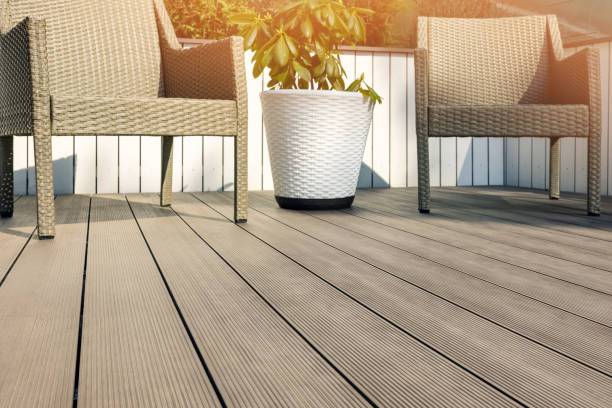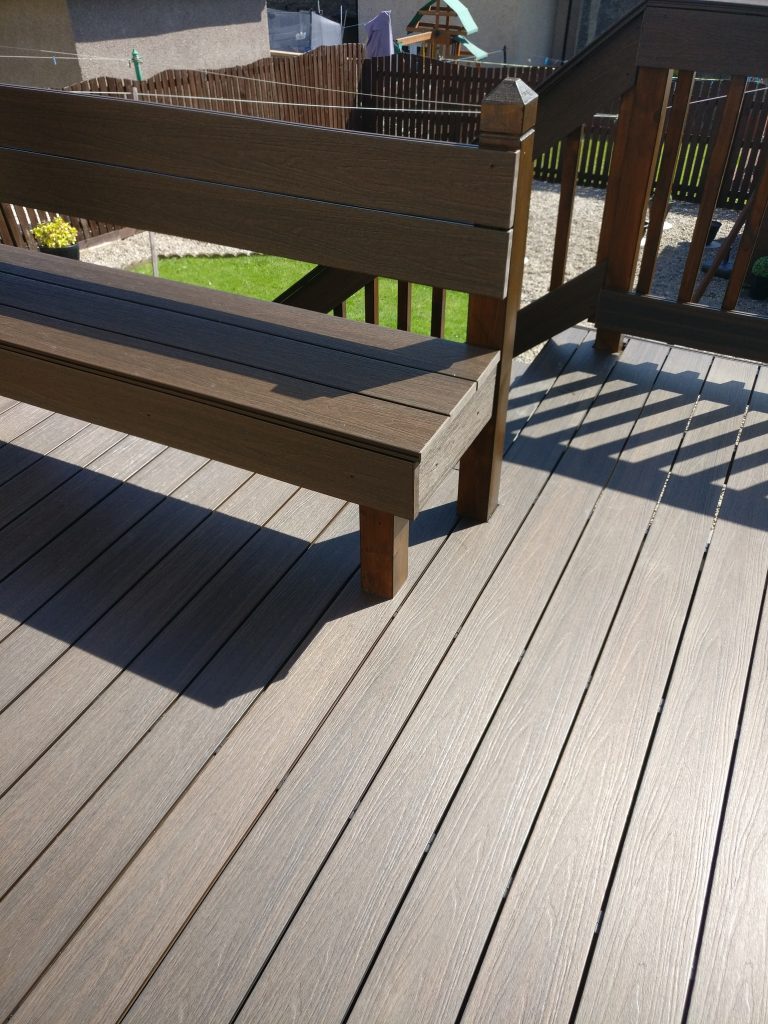Composite decking has gained immense popularity as a durable and low-maintenance alternative to traditional wood decking. Its innovative composition of wood fibres and plastic provides numerous advantages, such as resistance to rot, splintering, and insect damage, making it an attractive option for homeowners. Like any building material, composite decking comes with its own set of considerations and installation requirements.
In this comprehensive guide, we will explore the advantages and disadvantages of composite decking, the proper installation process, and address common questions such as the necessity of leaving gaps between decking boards and the potential consequences of neglecting this crucial step. Whether you are considering a composite deck for your home or are in the midst of planning an installation, this article will equip you with the knowledge and insights needed to make informed decisions and ensure a successful project.

What Is Composite Decking?
Composite decking is a type of outdoor flooring material that is designed as a wood-alternative for deck construction.
It is composed of a blend of wood fibres, recycled plastics, and bonding agents, providing the aesthetics of natural wood with added durability and low maintenance. One of the key benefits of composite decking is its resistance to rot, mould, and insects, making it an ideal choice for outdoor spaces. It’s eco-friendly due to its use of recycled materials, and it comes in various colour options to suit different design preferences. Its versatility and long-lasting nature make it a popular choice for residential and commercial applications.
What are the benefits of composite decking?
Composite decking offers various advantages, including its suitability as a wood-alternative for deck construction and its versatile design options.
It is highly durable and requires minimal maintenance, making it a practical choice for homeowners. Unlike traditional wood decking, composite materials are resistant to rot, mould, and insect damage, ensuring longevity and minimising the need for costly repairs.
Composite decking comes in a wide range of colours, textures, and finishes, allowing homeowners to customise their outdoor living spaces according to their preferences and design aesthetics. This versatile material is an excellent option for creating a beautiful and functional deck that enhances the overall appeal of a home.

What Are The Disadvantages Of Composite Decking?
Whilst composite decking offers numerous advantages, it also presents certain disadvantages that may impact deck renovation or upgrade projects.
One potential drawback of composite decking is its higher cost compared to traditional wood options. Composite decking has been known to retain more heat than wood, leading to discomfort when walking barefoot in hot weather. Another limitation is the relatively limited colour choices available, which may not fully satisfy the aesthetic preferences of homeowners. Considering these factors is crucial when making decisions about deck materials for renovation or upgrade projects.
How To Install Composite Decking?
The installation process for composite decking involves several key steps to ensure a successful and aesthetically pleasing deck surface.
- Prepare the area where the deck will be installed by clearing the space of any debris, ensuring a level foundation, and checking for any potential obstacles such as pipes or cables.
- Follow the manufacturer’s guidelines for fastening the composite decking boards. Proper fastening techniques are crucial for the longevity and structural integrity of the deck. Consider factors such as ventilation, spacing, and weight distribution during the deck building process to ensure a durable and beautiful end result.
Prepare The Area
Before fitting composite decking, it is essential to thoroughly prepare the designated area, ensuring a suitable foundation for the deck boards and a stable deck surface.
This pre-installation process starts with evaluating the site’s overall condition and adequacy for supporting the deck. The substructure should be inspected for structural integrity and proper joist spacing, as this directly impacts the stability and longevity of the deck.
Surface assessment involves examining the existing material for any damage, moisture issues, or unevenness that may need to be addressed before proceeding with the installation of the composite deck boards.
Lay The Foundation
Laying a strong foundation is crucial for the successful installation of composite decking, requiring adherence to effective deck building techniques and construction principles.
By starting with a well-constructed substructure that provides strong support and stability, the foundation for the composite decking is set. Proper framing considerations, such as ensuring the structure is level and securely anchored, are essential to maintain the integrity and longevity of the deck. Incorporating best practices in deck construction, including proper spacing and fastening methods, ensures a durable and visually appealing result. Understanding these key aspects of deck building is pivotal for a successful composite decking installation.
Place the composite decking boards
Placing the composite decking boards involves meticulous attention to proper spacing and fastening techniques to ensure a structurally sound and visually appealing deck surface.
Ensuring consistent deck spacing between boards is essential for allowing proper airflow and expansion and contraction of the decking material. Typically, a 3mm gap between boards is recommended to accommodate for changes in temperature and humidity. Alignment is crucial, and using a chalk line can help maintain a straight and uniform layout.
When it comes to fastening, utilising hidden fastening systems or stainless-steel screws can provide a neat finish and secure hold, while also preventing potential water damage and deck rot over time.
Secure The Boards
Securing the composite decking boards is a critical step in the installation process, directly impacting the long-term performance and maintenance requirements of the deck.
It is essential to use the appropriate fastening method to ensure the boards are securely attached, preventing warping, buckling, and potential hazards. Utilising hidden fastening systems or surface screws can provide a clean, seamless appearance while enhancing the structural integrity. Regular maintenance, including inspecting and tightening fasteners as needed, is vital for preserving the deck’s longevity.
Considering environmental factors and selecting high-quality, corrosion-resistant fasteners also contributes to the durability and aesthetic appeal of the composite deck.
Do I Need To Leave Gaps Between Composite Decking Boards?
A common question during composite decking installation pertains to the necessity of leaving gaps between the decking boards to accommodate expansion and contraction.
This is a critical consideration as composite decking, like any outdoor material, is subject to natural expansion and contraction due to changes in temperature and humidity. Without adequate spacing, the boards may buckle, warp, or become damaged over time. Properly spaced decking boards allow for water drainage, airflow and prevent moisture build-up, which can lead to mould or mildew.
Therefore, understanding and implementing decking expansion and contraction considerations is essential for the longevity and structural integrity of the deck.
What Are The Reasons For Leaving Gaps?
Leaving gaps between composite decking boards serves multiple purposes, including facilitating drainage, preventing buckling, and promoting airflow for gapless decking solutions.
These gaps are essential for allowing water to drain from the surface of the deck, which helps to prevent excessive moisture build-up that can lead to mould and mildew. The spaces between the boards allow for better airflow, reducing the likelihood of moisture becoming trapped underneath the decking. This airflow also plays a significant role in maintaining the structural integrity of the decking, as it prevents heat and moisture from becoming trapped and causing the boards to warp or buckle over time.
What Happens If I Install Composite Decking Without Gaps?
Installing composite decking without proper spacing can lead to potential issues such as buckling, warping, and the accumulation of moisture that may contribute to mould growth.
This lack of adequate spacing can cause the boards to be subjected to excessive pressure and movement, leading to structural impacts. The trapped moisture can also accelerate the deterioration of the decking material, potentially resulting in warping and bowing.
In addition, the presence of moisture creates a conducive environment for mould growth, which not only affects the aesthetics of the deck but also poses health risks. Therefore, ensuring proper spacing during the installation of composite decking is crucial for its long-term structural integrity and durability.
Can it cause buckling or warping?
Improper spacing during composite decking installation can indeed lead to buckling or warping issues, compromising the stability and visual appeal of the composite decking planks.
Insufficient spacing between the composite decking planks can cause them to press against one another, leading to excessive pressure and friction. This can result in the planks buckling or warping over time, creating uneven surfaces and potential tripping hazards. Inadequate spacing may contribute to poor ventilation, leading to the accumulation of moisture and debris, further accelerating the deterioration of the decking material.
These consequences emphasise the importance of precise spacing to ensure the longevity and aesthetics of the composite decking installation.
Can it trap moisture and cause mold growth?
Installing composite decking without proper gaps can create conditions conducive to moisture entrapment, potentially leading to mould growth and necessitating extensive deck renovation.
This issue arises due to the lack of adequate air circulation, with trapped moisture providing an ideal environment for mould to thrive. It’s crucial to address this concern during the renovation process by ensuring proper spacing for the decking materials. Integrating efficient drainage solutions can help prevent moisture build-up and enhance the longevity of the deck. Renovating with these considerations in mind not only mitigates mould growth risks but also contributes to the overall structural integrity of the deck.
How much space should be left between composite decking boards?
Determining the appropriate gap between composite decking boards is a critical aspect of the installation process, influencing deck spacing and board placement for optimal performance.
Maintaining proper spacing between boards not only allows for natural expansion and contraction of the composite material with changing weather conditions but also helps facilitate drainage and airflow to prevent moisture build-up.
Industry best practices recommend a minimum 1/8-inch gap between boards to accommodate for temperature-related expansion. Aligning the boards with consistent spacing ensures a visually appealing and structurally sound deck surface.
By following these guidelines, homeowners can ensure the longevity and durability of their composite decking installation.
What Are The Alternatives To Leaving Gaps Between Composite Decking Boards?
For those seeking alternatives to leaving gaps between composite decking boards, options such as utilising hidden fixings or employing butt joints present viable solutions for a gapless decking installation.
Hidden fastener systems provide a sleek and seamless appearance to the deck surface by securing the boards from below, eliminating the need for visible screws or nails. Butt joint applications offer a clean and unbroken surface while reducing the expansion and contraction of decking material.
Integrating these alternative installation methods ensures a smooth and continuous look for a gapless decking solution, enhancing both aesthetic appeal and functionality.
Using Hidden Fasteners
Incorporating concealed fixings offers a seamless and visually appealing approach to decking without gaps, preserving the clean aesthetic of the deck surface while ensuring structural integrity.
The installation process of concealed fixings involves securing them to the joists underneath the deck boards, allowing the boards to be fastened from below the surface. This not only eliminates surface screws or nails but also creates a smooth, unblemished appearance. Concealed fixings promote better airflow, reducing the risk of moisture buildup and potential rot. This gapless solution ensures a safe and secure deck surface, while also enhancing the overall visual appeal.
Using Butt Joints
Utilising butt joints provides an alternative method for creating a gapless composite decking installation, requiring strategic placement and secure fastening for effective deck building advice.
This method involves connecting the ends of individual decking boards perpendicular to each other, rather than overlapping them. When installing composite decking with butt joints, it’s crucial to ensure precise alignment and spacing to prevent uneven sections. Proper support and framing are essential to maintain structural integrity, making it necessary to consider joist spacing and overall layout.
Proper expansion gaps and regular maintenance also play vital roles in the longevity of a composite deck utilising butt joints.






